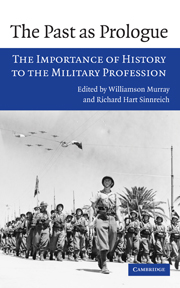Book contents
- Frontmatter
- Contents
- Contributors
- 1 Introduction
- 2 Military history and the history of war
- Part I The influence of history on the military profession
- Part II The past as illuminator of the future
- 7 Thucydides as educator
- 8 Clausewitz, history, and the future strategic world
- 9 History and the nature of strategy
- 10 Military transformation in long periods of peace: the Victorian Royal Navy
- 11 Military history and the pathology of lessons learned: the Russo-Japanese War, a case study
- 12 Obstacles to innovation and readiness: the British Army's experience, 1918–1939
- 13 What history suggests about terrorism and its future
- 14 History and future of civil–military relations: bridging the gaps
- Index
10 - Military transformation in long periods of peace: the Victorian Royal Navy
Published online by Cambridge University Press: 05 June 2012
- Frontmatter
- Contents
- Contributors
- 1 Introduction
- 2 Military history and the history of war
- Part I The influence of history on the military profession
- Part II The past as illuminator of the future
- 7 Thucydides as educator
- 8 Clausewitz, history, and the future strategic world
- 9 History and the nature of strategy
- 10 Military transformation in long periods of peace: the Victorian Royal Navy
- 11 Military history and the pathology of lessons learned: the Russo-Japanese War, a case study
- 12 Obstacles to innovation and readiness: the British Army's experience, 1918–1939
- 13 What history suggests about terrorism and its future
- 14 History and future of civil–military relations: bridging the gaps
- Index
Summary
The title of this essay suggests that what happened to the Royal Navy in the long Victorian peace is important because it may happen, or be happening, again. The author will not speculate on that. What he had to decide was to treat the state of internavy (or inter-great-power) war as the fundamental task for which navies exist, and that tasks lower down on the scale of violence, however beneficial, are what a serious warfighting navy does only when it has no serious wars to fight. In times of strategic change, although it is not terribly important how well a navy makes the transformation from warfighting to operations other than war, it is important how well and fast it makes the change back again when great power conflict reemerges. So this chapter focuses not only on how the Victorian Navy transformed itself into the peace support machine of Pax Britannica, but also on how those peaceful habits may have hindered its return to what one might call “main armament warfare.”
If we are to regard interfleet warfare, or at least warfare to contest the use of the sea, as the fundamental task for which navies exist, then the Victorian Navy confronted during the long calm after Trafalgar a lapse of three generations before having to do it again. There must have been those in the service, anytime between, say, 1830 and 1880, who must have wondered if the era of great power confrontation at sea would ever return, even though the world's navies emphasized warships on the basis of their ship-killing guns.
- Type
- Chapter
- Information
- The Past as PrologueThe Importance of History to the Military Profession, pp. 150 - 169Publisher: Cambridge University PressPrint publication year: 2006
- 1
- Cited by



